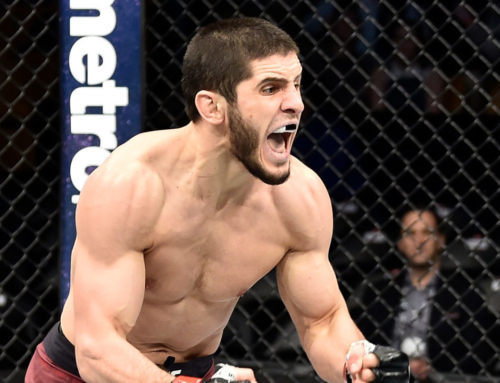By Alistair Hendrie
Scan the UFC roster and in almost every weight class, you’ll find a handful of athletes who’ve struggled to hit their division’s weight limit this year. Indeed, from January 2018 to July 2018, UFC competitors missed weight twelve times. Although that’s a small number of fighters coming in heavy from a sample of 21 events, consider if even half of those weight-drained fighters eventually had their careers – or lives – cut short. The effects of weight cutting such as dehydration of the brain or kidney failure can be catastrophic, and as such, the culture of slashing off the pounds at the last minute is one of mixed martial arts’ biggest conundrums.
Adding new weight divisions, Kevin Lee believes, could be the answer. “Most people, especially 155lbs’ers, all want it (additional weight classes),” said “The Motown Phenom,” speaking to Luke Thomas of MMA Fighting. “If we can make it a little bit safer and fairer, that’s all I’m calling for. I just want a fair, even playing field for me to go out there and compete without having to kill myself to do it. 10 pounds makes a huge difference – if you had divisions for 165lbs and 175lbs, you wouldn’t have people cutting from 200lbs to make welterweight; they could just fight at 175lbs.”
The California State Athletic Commission (CSAC) had added to the argument by publishing fight night weights after each of its cards. Its data from UFC 227 in August revealed that two thirds of fighters were at least 10% heavier than their division’s limit once they stepped into the cage. One of those, featherweight Renato Moicano, came in at 165.5lbs, 13.4% above the mark.
Battling the scales is of course a problem at all levels of the sport but for argument’s sake, it’s important to look at how the UFC could implement more weight categories. (Although the UFC added women’s flyweight and featherweight divisions since 2017, its newest men’s division – flyweight – opened back in 2012). With the facilities at the Las Vegas-based promotion’s visionary Performance Institute, and the support and guidance from athletic commissions, the stage could be set for the UFC to load up on weight divisions and cull the problem of weight-cutting for good.
Where has the argument for more weight classes come from?
When the UFC opened in 1993, much of its appeal was based on finding out whether or not a smaller man, the likes of Royce Gracie, could defeat a bigger man. Although the sport has progressed to the uniform weight classes we see today, combatants are still depleting themselves to make weight and it’s even a problem at heavyweight, where most promotions feature a limit between 225lbs and 265lbs.
In 2016, heavyweight Dada 5000 revealed he suffered kidney failure and two heart attacks during his TKO defeat to Kimbo Slice – he attributed this partly to stripping 40lbs during his fight camp. Middleweight Urijah Hall was trying to shed the pounds a year later for his UFC dust-up with Vitor Belfort when he suffered a seizure and a minor heart attack. Perhaps if they’d had a little more room for manoeuvre – 10 or 15lbs, for instance – Dada 5000 and Hall would have avoided their ordeals.
Which weight classes would the UFC be sensible to introduce?
It’s fair to say there’s space for the UFC to add at least three or four more men’s divisions – super-welterweight (175lbs) and super-heavyweight (over 266lbs) to give two examples. For the purpose of debate, though, we could initially analyse in detail the potential for men’s light-welterweight (165lbs) and men’s super-middleweight (195lbs).
Light-welterweight would benefit plenty thanks to the chasm of 15lbs between lightweight (155lbs) and welterweight (170lbs). Dan Hooker, the 6 foot lightweight, is blessed with a lanky frame and a 75 inch reach, so he could thrive at 165lbs. Rafael dos Anjos, too sturdy for lightweight but undersized when he steps up, would also prosper in a 165lbs scene.
Then there’s super-middleweight, which could be a home for the former middleweight king, Chris Weidman. Once you start putting together super-middleweight crackers such as Israel Adesanya against Yoel Romero, the potential for excitement becomes even clearer. Adesanya, the anomaly with an 80 inch reach, towers five inches above Daniel Cormier, the light-heavyweight and heavyweight leader, and fans would surely pay good money to see how “The Last Stylebender” would negate Romero’s bull-rushing raids.
How could the UFC accommodate new divisions?
It took the UFC five years, until UFC 12 in 1997, to introduce weight classes, the first of which were lightweight (199lbs and under) and heavyweight (200lbs and over). As history has shown, patience is key with any untested UFC venture and when the new weight categories arrive, they will do so at the right time.
It would be wise to stagger the introduction of new divisions – perhaps two in the next year – with tournaments to determine the inaugural titlist. Immediate semi-finals with a reserve in waiting would be the best course of action, so as to get the division moving.
However, the dilemma remains, how will the UFC squeeze the newest weight classes into an already jam-packed roster? With the UFC hosting 41 shows in 2015, 2016 and 2017, will we see more output, overwhelming the market even further? Who knows? An expansion of weight classes could also spell more pound-for-pound pace-setters on regional cards – great news for British and European fans.
Whatever happens, with the likes of Lee speaking out and fighters suffering organ failure after a rough time making weight, this is a black cloud for the UFC and mixed martial arts as a whole. Sooner or later, common sense must prevail, and promotions need to look at the evidence which is staring them in the face. Opening new weight divisions isn’t easy – it’s not a catch-all, overnight solution which will immediately stop athletes crashing weight, but it’s a step in the right direction if nothing else.
“Check out more of Alistair Hendrie’s work with his Kindle book, Fight Game: The Untold Story of Women’s MMA in Britain, which features insight from Rosi Sexton, Joanne Calderwood and many more.”






